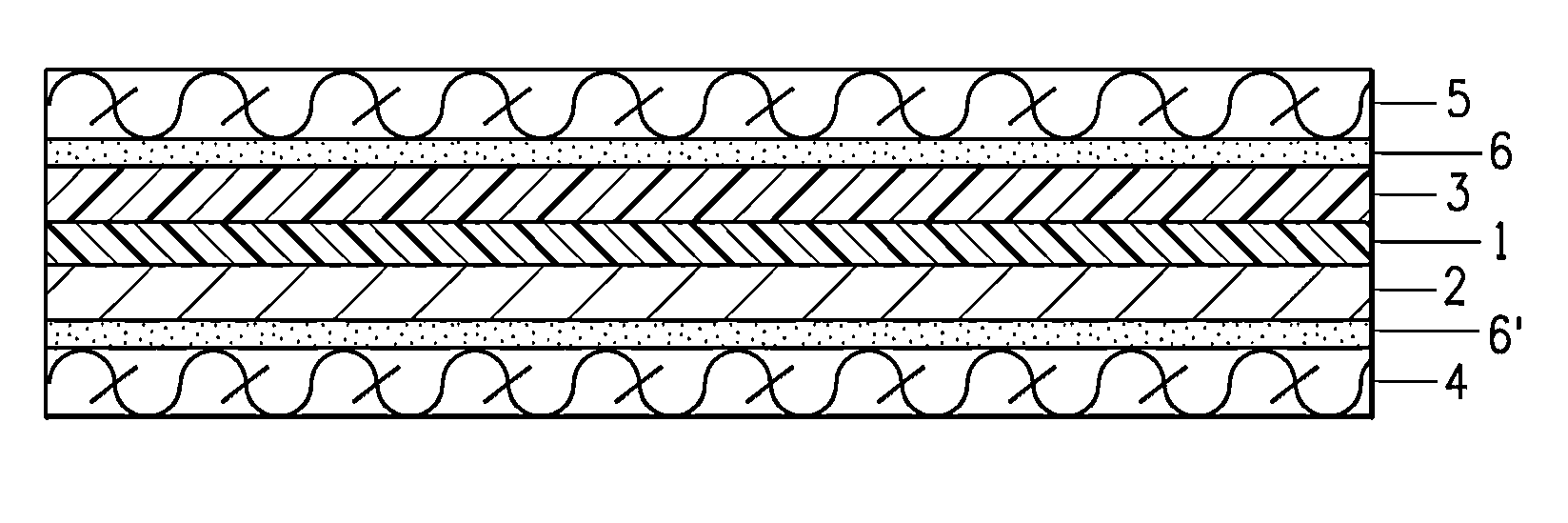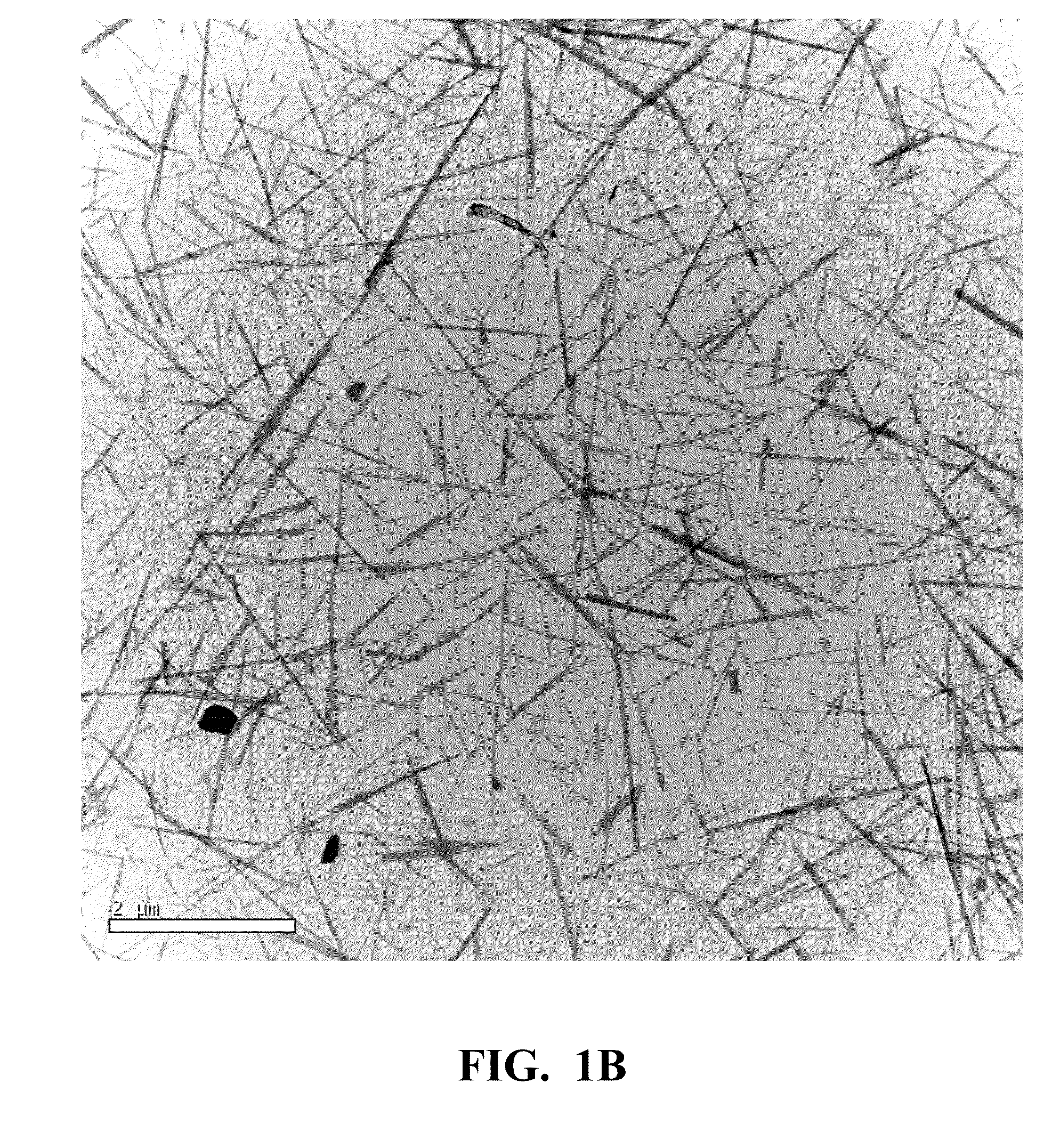Chitosan films with reduced shrinkage and laminates made therefrom
a technology of chitosan and shrinkage, applied in the field of chitosan films, can solve the problems of short period of time, personal discomfort, and high heat of the structure, and achieve the effects of reducing the risk of skin cancer, and reducing the number of cancers
- Summary
- Abstract
- Description
- Claims
- Application Information
AI Technical Summary
Benefits of technology
Problems solved by technology
Method used
Image
Examples
example 1
Preparation of Purified Sepiolite
[0122]The as-received sepiolite Pangel® 59 (Grupo Tolsa SA Madrid, Spain) was purified by the following procedure:
[0123]33.0 g tetrasodium pyrophosphate decahydrate (TSPP, Aldrich 221368) was dissolved in 3.3 L water in a 1-gallon jug while stirring with an overhead stirrer for 5 minutes. 100 g of sepiolite Pangel® S9 (Tolsa SA) was slowly added while mixing vigorously for 15 min. The slurry was further dispersed by passing it through a Microfluidics Corp. Microfluidizer Model 110Y four times. Sediment was allowed to settle out for at least 6 days. The sediment was separated from the supernatant by decantation. The purified sepiolite was separated from the supernatant in a tube centrifuge driven by compressed air (40 psi) with a flow rate of about 250 mL / min. The solid content in the wet-cake thereby produced, which was typically about 55%, was the purified sepiolite.
[0124]The purified sepiolite was re-dispersed by adding 1757 g water in a 1-gallon p...
example 2
Chitosan Acetate with 5 wt % Purified Sepiolite (Based on Total Solids in the Film)
[0125]A 6% chitosan acetate solution was made as described in Comparative Example 1. One hundred fifty grams of this solution was mixed with 16.33 grams of purified sepiolite slurry with a sepiolite concentration of 2.9% based on total solution weight with an IKA Ultra-Turrax T-25 high-shear mixer at 13,500 RPM with a “milkshake” style motion. The chitosan solution and sepiolite slurry were mixed for 5 minutes, stopped for 1 minute, then further mixed for 3 more minutes. It was then allowed to stand for 24 hours to degas.
[0126]The added purified sepiolite slurry had been made by adding 2.67 g of purified sepiolite into 80 g water in a 100 mL glass bottle. The purified sepiolite (prepared as in General Methods) had been dried and was added as a powder, rather than the wet cake as indicated in the sepiolite purification procedure above. The calculation therefore assumed that this powder picked up 10% wa...
example 3
Chitosan Acetate with 4.8 wt % Purified Sepiolite (Based on Total Solids in the Film)
[0128]A 4.8% chitosan acetate solution was made by first mixing 390 g of water and 10 g acetic acid using an overhead agitator with a paddle blade. The mixture was heated to 75° C. while 20 g of ChitoClear® TM-656 (Primex Inc.) powder was added. Mixing continued for 3 hours. One hundred fifty grams of this chitosan acetate solution was mixed with 12.5 g of purified sepiolite slurry (prepared as described in Example 1) with a sepiolite concentration of 2.9% with an IKA Ultra-Turrax T-25 high-shear mixer at 10,000 RPM with a “milkshake” style motion. It was mixed for 5-10 minutes and then allowed to stand for 24 hours to degas.
[0129]A film was cast from the supernatant chitosan / sepiolite slurry onto a PET sheet (7 mils; 178 μm) by using a doctor's blade with an opening of 500 μm. The film was dried as in Comparative Example 1. The calculated sepiolite concentration of this dried 13 μm-thick film was 4...
PUM
| Property | Measurement | Unit |
|---|---|---|
| thick | aaaaa | aaaaa |
| boiling point | aaaaa | aaaaa |
| lengths | aaaaa | aaaaa |
Abstract
Description
Claims
Application Information
 Login to View More
Login to View More - R&D
- Intellectual Property
- Life Sciences
- Materials
- Tech Scout
- Unparalleled Data Quality
- Higher Quality Content
- 60% Fewer Hallucinations
Browse by: Latest US Patents, China's latest patents, Technical Efficacy Thesaurus, Application Domain, Technology Topic, Popular Technical Reports.
© 2025 PatSnap. All rights reserved.Legal|Privacy policy|Modern Slavery Act Transparency Statement|Sitemap|About US| Contact US: help@patsnap.com



